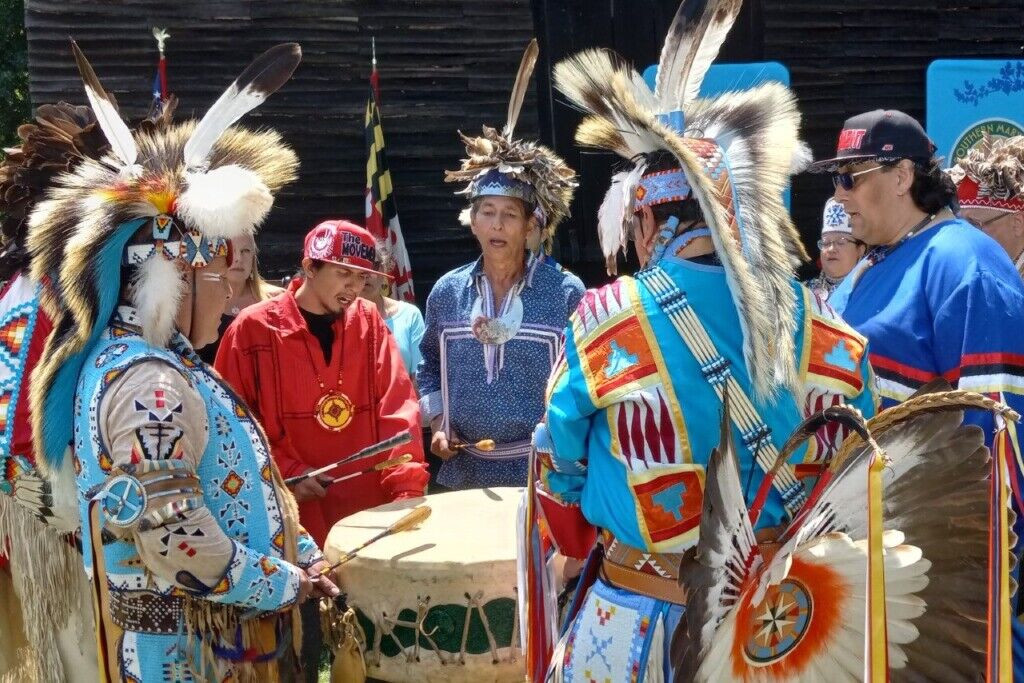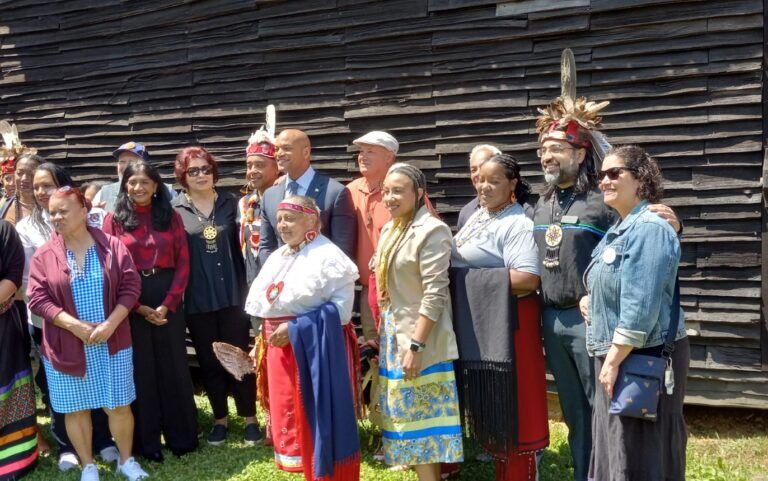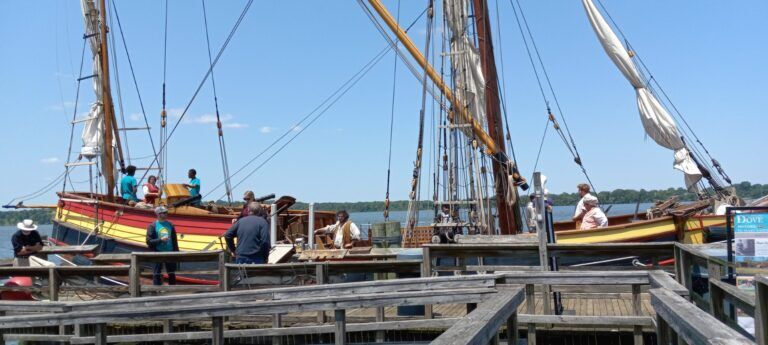This article was republished with permission from WTOP’s news partners at Maryland Matters. Sign up for Maryland Matters’ free email subscription today.

This content was republished with permission from WTOP’s news partners at Maryland Matters. Sign up for Maryland Matters’ free email subscription today.
There is something new in Maryland that celebrates something old. It’s designed to shed light on some of the state’s hidden history and neglected recreational gems, and state and local leaders hope it will prime the pump of the local economy in Southern Maryland.
Dozens of politicians and dignitaries flocked to a remote shoreline of the Potomac River in Accokeek on Thursday to celebrate the recent establishment of the Southern Maryland National Heritage Area.
The new federal designation spotlights the area’s American Indian legacy, natural splendor and cultural and historic significance, and eases the way for visitors to tour and learn more about Calvert, Charles and St. Mary’s counties and the small slice of Prince George’s County that’s also considered part of Southern Maryland. It’s the 62nd national heritage area in the U.S.
“They are grass-roots, community-driven approaches to heritage, conservation and economic development,” said Shannon Estenoz, assistant secretary for Fish, Wildlife and Parks at the U.S. Department of the Interior. These public-private partnerships also seek to “tell a more complete story about America,” she said.
Despite its proximity to the region’s population centers, Southern Maryland is often forgotten in conversations about the state’s recreational and tourism opportunities, and local leaders are hoping the new designation, which ws part of legislation pushed by Maryland’s congressional leaders and signed into law by President Biden earlier this year, changes that dynamic.
But Thursday’s celebration was weighted by emotion and the fraught history of colonialism and slavery. Gov. Wes Moore (D), the keynote speaker, used the occasion to advance his argument, which is swiftly gaining national attention, against political leaders who are trying to erase the messiest aspects of U.S. history.
The event took place at Piscataway Park, a wildlife and cultural preservation area in the southernmost corner of Prince George’s County, 20 miles from downtown Washington, D.C., that’s maintained by the National Park Service — and it’s on sacred ground that belonged to the Piscataway Indian Nation. The park sits on land that was once the Village of Moyaone, the tribe’s seat of government for centuries.
So the dedication Thursday became a ceremony of remembrance and reconciliation, with tribal leaders speaking both about the long struggle to obtain recognition and rights from the federal government, but also welcoming the crowd to their homeland and expressing gratitude for the preservation of their history that the new heritage area aims to achieve. Southern Maryland is where English settlers first arrived in Maryland.
“Four hundred years ago we welcomed people to our lands and to our shores. It’s 400 years later and we’re still extending our hands in friendship,” said Mark Tayac, chief of the Piscataway Indian Nation.
The program opened with a tribal drum circle and honoring ceremony, and Piscataway leaders presented Moore with a necklace, which he wore around his neck, and a blanket, which he draped around his shoulders until it was his turn to speak. The governor reciprocated by presenting the tribal leaders with a gift of tobacco and shells, wrapped in a handsome leather-covered box.

Francis Gray, chair of the Piscataway Conoy Tribe, said the heritage designation in Southern Maryland creates “the opportunity to invert our colonial narrative,” and said it will enable local residents and visitors to learn more about the region’s history, with an eye toward a better future.
“Our worlds have once again converged, and it is here that we have the opportunity for all Marylanders and all Piscataways to attain that critical knowledge,” he said.
Moore picked up on that theme during his speech.
“While Southern Maryland has a complicated history, while Maryland has a complicated history, while the United States has a complicated history, we know that we can learn that history and we celebrate that history — not to diminish anyone, but to empower everybody,” he said. “That’s what this Southern Maryland National Heritage Area is going to accomplish.”
Moore compared the conversation that the new federal designation is inspiring to the “systemic erasure of history that is happening across the country.” He decried political leaders who seek to ban books, limit school curricula and intimidate teachers and say they’re doing so to spare Americans the pain and guilt of the nation’s history of injustice, and said there is a political motive to their actions.
“This is not an attempt to make people not feel uncomfortable,” Moore said. “This is a fear of people understanding their actual power. If you know your history, there is nothing about the future that makes you flinch…Here in Maryland, here in Southern Maryland, we celebrate our history, we embrace our history — good, bad and empowering.”
Moore made similar comments as the keynote speaker at the Morehouse College graduation in Atlanta last Sunday, and on MSNBC’s “Morning Joe” on Thursday morning.
At one point, Moore asked everyone in the audience to join hands to show “we stand in unity.” Shouts of “Amen!” and “Praise the Lord” rang out from the crowd. Moore smiled approvingly when someone yelled, “Praise the Lord — to everybody!” Earlier in the program, Tayac had asked two dozen tribal leaders to join hands as they stood in front of Moore, Lt. Gov. Aruna Miller (D) and federal officials.
“This is a new dialogue, and it’s profound,” said Lucille Walker, executive director of the Southern Maryland National Heritage Area.

Although the program leaned heavily on the history of the Piscataway in Southern Maryland, the new federal designation is expected to be a boon for several area cultural and conservation organizations, many of whom had informational tables set up at the park. The Maryland Dove, a replica of a 17th century ship that is usually docked in Historic St. Mary’s City, was moored on the Potomac in Accokeek, and crew members offered tours.
Among other things, the designation brings an extra $10 million of federal aid into the area over the next decade, and the National Park Service also provides technical and programmatic support, Estenoz said. The Tri-County Council of Southern Maryland will manage the grants and head the project. Over the next three years, Estenoz said, local leaders will develop a comprehensive management plan for the area, incorporating the “community vision.”
“We celebrate what we have accomplished and we kick off the work we have ahead of us, which is considerable but so exciting,” she said.
The new Southern Maryland National Heritage Area becomes the second national heritage area centered in Maryland; the other is the Baltimore National Heritage Area, which spotlights history throughout the city. There are also two multi-state heritage areas that include Maryland: the Appalachian Forest National Heritage Area, which takes in parts of Maryland and West Virginia, and the Journey Through Hallowed Ground National Heritage Area, which includes parts of Maryland, Pennsylvania, Virginia and West Virginia.







